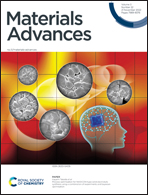Water oxidation at low potential exploiting a nitroxide/oxoammonium ion redox couple as mediator†
Abstract
The oxoammonium cation (OAC) of 3-carboxy proxyl, a nitroxide radical (NitR), could be produced either by chemical or by electrochemical oxidation (0.8–1.0 V vs. NHE) of the radical. We have determined that in dilute aqueous basic solutions (pH ≥ 9), OAC is reduced quantitatively to the original radical with concomitant formation of molecular oxygen in a ratio ca. 4 : 1 (4 moles of OAC reduced per 1 mole of O2), and the redox cycle can be repeated. The low electrolysis potential (0.8 V) contrasts with the high redox potential of the bare OH− anion (2–2.6 V vs. NHE for the first outer-sphere electron transfer). This apparent thermodynamic paradox was solved by a careful study of its possible mechanism. In our opinion, OAC/NitR's may represent a new class of redox mediators for a novel approach to water oxidation (and generation of molecular oxygen) at a low potential.

- This article is part of the themed collection: Celebrating materials science in Italy


 Please wait while we load your content...
Please wait while we load your content...